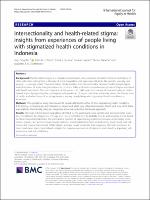System dynamics modelling of health workforce planning to address future challenges of Thailand’s Universal Health Coverage
| Leerapan, Borwornsom
Teekasap, Pard Urwannachotima, Nipaporn Jaichuen, Wararat Chiangchaisakulthai, Kwanpracha Udomaksorn, Khunjira Meeyai, Aronrag Noree, Thinakorn Sawaengdee, Krisada |
|
| 2021-03-10 | |
|
Background: System dynamics (SD) modelling can inform policy decisions under Thailand's Universal Health Coverage. We report on this thinking approach to Thailand's strategic health workforce planning for the next 20 years (2018–2037). Methods: A series of group model building (GMB) sessions involving 110 participants from multi-sectors of Thailand's health systems was conducted in 2017 and 2018. We facilitated policymakers, administrators, practitioners and other stakeholders to co-create a causal loop diagram (CLD) representing a shared understanding of why the health workforce's demands and supplies in Thailand were mismatched. A stock and flow diagram (SFD) was also co-created for testing the consequences of policy options by simulation modelling. Results: The simulation modelling found hospital utilisation created a vicious cycle of constantly increasing demands for hospital care and a constant shortage of healthcare providers. Moreover, hospital care was not designed for effectively dealing with the future demands of ageing populations and prevalent chronic illness. Hence, shifting emphasis to professions that can provide primary care, intermediate care, long-term care, palliative care, and end-of-life care can be more effective. Conclusions: Our SD modelling confirmed that shifting the care models to address the changing health demands can be a high-leverage policy of health workforce planning, although very difficult to implement in the short term. |
|
| Human resource for health
Health workforce Strategic planning Care delivery models Health systems performance Group model building Causal loop diagram System dynamic modelling |
|
| Research paper | |
| Text | |
| application/pdf | |
| This work is licensed under a Creative Commons Attribution 4.0 International license (CC BY 4.0). | |
| Open access | |
| Copyright (c) 2021 The Author(s) | |
| https://resources.equityinitiative.org/handle/ei/644 |
This item appears in the following Collection(s) |
|
|
Collections
|
Related items
Showing items related by title, author, creator and subject.
-
Human resources for health: task shifting to promote basic health service delivery among internally displaced people in ethnic health program service areas in eastern Burma/Myanmar
Low, Sharon; Tun, Kyaw Thura; Mhote, Naw Pue Pue; Htoo, Saw Nay; Maung, Cynthia; Kyaw, Saw Win; Oo, Saw Eh Kalu Shwe; Pocock, Nicola Suyin (2014-09-29)
Background: Burma/Myanmar was controlled by a military regime for over 50 years. Many basic social and protection services have been neglected, specifically in the ethnic areas. Development in these areas was led by the ethnic non-state actors to ensure care and the availability of health services for the communities living in the border ethnic-controlled areas. Political changes in Burma/Myanmar have been ongoing since the end of 2010. Given the ethnic diversity of Burma/Myanmar, many challenges in ensuring health service coverage among all ... -
Can mHealth and eHealth improve management of diabetes and hypertension in a hard-to-reach population? —lessons learned from a process evaluation of digital health to support a peer educator model in Cambodia using the RE-AIM framework
Steinman, Lesley; Pelt, Maurits van; Hen, Heang; Chhea, Chhorvann; Lan, Channe Suy; Te, Vannarath; LoGerfo, James; Fitzpatrick, Annette L. (2020-10-05)
Background: The burden of non-communicable diseases (NCDs) is increasing in low- and middle-income countries (LMICs) where NCDs cause 4:5 deaths, disproportionately affect poorer populations, and carry a large economic burden. Digital interventions can improve NCD management for these hard-to-reach populations with inadequate health systems and high cell-phone coverage; however, there is limited research on whether digital health is reaching this potential. We conducted a process evaluation to understand challenges and successes from a digital ... -
Intersectionality and health-related stigma: insights from experiences of people living with stigmatized health conditions in Indonesia
Rai, Sarju Sing; Peters, Ruth M. H.; Syurina, Elena V.; Irwanto, Irwanto; Naniche, Denise; Zweekhorst, Marjolein B. M. (International Journal for Equity in Health, 2020-12)
Abstract Background Health-related stigma is a complex phenomenon, the experience of which intersects with those of other adversities arising from a diversity of social inequalities and oppressive identities like gender, sexuality, and poverty – a concept called “intersectionality”. Understanding this intersectionality between health-related stigma and other forms of social marginalization can provide a fuller and more comprehensive picture of stigma associated with health conditions. The main objective ...



